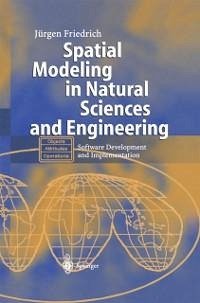The author introduces the reader to the creation and implementation of space-related models by applying a learning-by-doing and problem-oriented approach. The required procedural skills are rarely taught at universities and many scientists and engineers struggle to transfer a model into a computer program. The purpose of this book is to fill this gap. It moves from simple to more complex applications, covering various important topics in the sequence: dynamic matrix processing, 2D and 3D graphics, databases, Java applets and parallel computing. A file (SMOP.zip) with all examples can be downloaded free of charge from the Internet at http://de.geocities.com/bsttc2/book.
Dieser Download kann aus rechtlichen Gründen nur mit Rechnungsadresse in A, B, BG, CY, CZ, D, DK, EW, E, FIN, F, GR, HR, H, IRL, I, LT, L, LR, M, NL, PL, P, R, S, SLO, SK ausgeliefert werden.
From the reviews:
"This is one of the first books trying to introduce object-oriented theory and practise especially for spatial sciences. ... The examples may be used as starting point for own implementation because they are well described ... . Thus, I would recommend it for higher level graduate and postgraduate students as well as practitioners in the field of surveying, geodesy, cartography, photogrammetry ... . For these readers it will give a deeper insight into object-oriented concepts ... . will help beginners to do the first successful steps in object-orientation." (Ralf Bill, Photogrammetrie-Fernerkundung-Geoinformation, Issue 6, 2004)
"This is a well-presented book, with a clear structure and writing style, which is easy to follow. ... the author's objective has been achieved, as the book takes the reader smoothly from basic concepts behind object-oriented methodology to the building of models with objects and patterns, concluding with applied examples. ... the book is suitable for undergraduate students of Spatial Sciences and Engineering disciplines ... . would also be suitable for teaching units within distance-based graduate programmes in spatial sciences or engineering." (G. Metternicht, The Photogrammetric Record, Vol. 20 (109), March, 2005)
"This is one of the first books trying to introduce object-oriented theory and practise especially for spatial sciences. ... The examples may be used as starting point for own implementation because they are well described ... . Thus, I would recommend it for higher level graduate and postgraduate students as well as practitioners in the field of surveying, geodesy, cartography, photogrammetry ... . For these readers it will give a deeper insight into object-oriented concepts ... . will help beginners to do the first successful steps in object-orientation." (Ralf Bill, Photogrammetrie-Fernerkundung-Geoinformation, Issue 6, 2004)
"This is a well-presented book, with a clear structure and writing style, which is easy to follow. ... the author's objective has been achieved, as the book takes the reader smoothly from basic concepts behind object-oriented methodology to the building of models with objects and patterns, concluding with applied examples. ... the book is suitable for undergraduate students of Spatial Sciences and Engineering disciplines ... . would also be suitable for teaching units within distance-based graduate programmes in spatial sciences or engineering." (G. Metternicht, The Photogrammetric Record, Vol. 20 (109), March, 2005)

